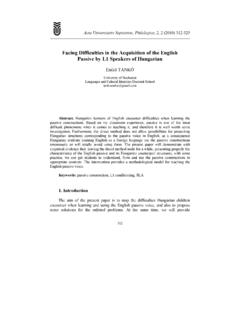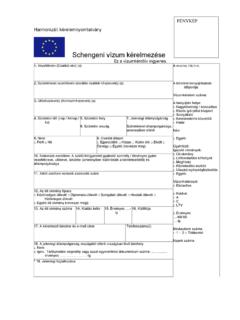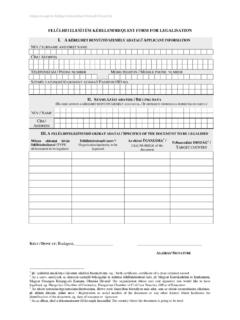Transcription of Waste Management - United Nations
1 Waste Management The hungarian Waste Management regime is being developed continuously, especially from the beginning of the EU accession procedure in the late 90s. The framework legislation has been established by the Act No. 53 of 2000 on Waste Management in conformity with the EU Directive 2006/12/EC on Waste . The mid-term Waste Management strategy of Hungary is defined in National Waste Management Plans (NWMP) prepared for six-year periods, of which the first planning period 2003-2008 has been just expired.
2 The new NWMP for 2009-2014 is under elaboration parallel to the upgrading of the Waste Management Act in order to harmonize national legislation, targets and implementation tools to the new EU Waste Framework Directive 2008/98/EC. Sustainable development is one of the basic elements of hungarian Waste Management policy and of the NWMP. The main principle is to follow and enforce the classic Waste Management hierarchy: prevention recovery - disposal. In order to ensure the sustainable use of natural resources it supports the use of technologies generating minimum amount of Waste with economical material and energy consumption, thereby preventing the pile-up of Waste ; utilization of materials producing less hazardous Waste , representing lower risk; as well as recovery the generated Waste materials and energy to the fullest extent by substitution of non-renewable natural resources with secondary raw materials.
3 And finally disposal of non-recoverable Waste in an environmentally friendly manner, that does not cause hazards to human health and to the environment and - as part of this - reduction to the minimum of Waste landfill. Concrete actions taken and specific progress made in implementation The main measures to be taken have been defined in the NWMP. Major tasks to be solved or managed by the implementation of NWMP are as follows: - reduce both the high absolute value of Waste generation and the high proportion of Waste generated, as compared to the production value; - increase the ratio of recovery which is low for most Waste types, encourage economical material and energy recovery; - minimize the currently high proportion of Waste disposal by landfill.
4 - gradually eliminate the sources of hazard and the contaminated sites which resulted from the unsuitable Waste disposal of the past decades; - promote - through market-conform economic instruments - the solutions that are beneficial in the long term, in accordance with the principles of sustainable development, and the construction of modern, complex Waste Management systems, having special regard to recovery; - promote research and technical development in line with achieving the goals of Waste Management ; - strengthen the co-operation between the state and the private sector, to support the local or local community initiatives, having special regard to selective Waste collection and recovery; - increase the efficiency of education, training and awareness raising activities.
5 Annual Waste production and the GDP 2000 2004 2005 2006 2007 2008* Total Waste production, 1000 tons/year 40 700 30 045 28 558 26 607 25 858 25 000 Total Waste production, % of the previous year GDP, % of the previous year Source: Ministry of Environment and Water * Estimated value Through legislative, economic and public relation measures, progress made in a number of areas: - The annual amount of Waste decreased by 38% (from some 41 million tons to 26 million tons) from 2000 to 2007, but municipal solid Waste generation changed from million tons to million tons.
6 In the same time period the GDP increased by about 35%. Generation of municipal solid Waste (MSW) and the GDP 2000 2001 2002 2003 2004 2005 2006 2007 2008* Generation of MSW , 1000 tons/year 4 552 4 603 4 646 4 693 4 591 4 646 4 711 4 594 4 400 Generation of MSW, % of the previous year GDP, % of the previous year Real income, % of the previous year Source: hungarian Central Statistical Office, Ministry of Environment and Water * Estimated value - The recovery rate of total generated Waste decreased from 27% to 25% but on municipal Waste this rate increased from 3% to 20% between 2000 and 2007.
7 - The rate of disposal by landfills decreased from 52% to 45% between 2000 and 2007 but municipal Waste landfill rate changed from 85% to 75%. Waste treatment in Hungary (without Waste water sludge) 2004 2005 2006 2007 tons % tons % tons % tons % Recycling 8 892 837 7 630 197 6 697 451 4 629 467 Energy recovery 911 322 1 271 472 1 627 237 1 354 938 Incineration 169 852 52 756 101 434 77 935 Landfill 17 415 456 13 602 494 14 288 930 11 325 094 Other 2 461 033 5 799 114 3 892 287 7 758 880 Source.
8 Database of the Waste Information System (HIR) Treatment of municipal solid Waste (1000 tons) 2000 2001 2002 2003 2004 2005 2006 2007 Recycling 350 360 400 490 540 444 490 554 Energy recovery 340 350 280 240 155 303 389 383 Landfill 3 760 3 800 3 890 3 900 3 857 3 859 3 792 3 428 Other 40 40 40 229 Source: hungarian Central Statistical Office, Ministry of Environment and Water * The fluctuation of the values of energy recovery is caused by the stopping the operation of the Waste Recovery Plant of Budapest and restarting it due to reconstruction.
9 - In accordance with the EU regulations Hungary introduced the extended producer responsibility for certain products ( Waste electrical and electronic equipment -WEEE, packaging, end of life vehicles - ELV, batteries), and fulfilled the EU obligations on the reduction of heavy metal contents of the goods available on the market, and Waste collection and recovery targets. - To promote the collection and recycling of certain products Waste a special product fee is used (on packaging, electronics, accumulators, tyres, oil-products, advertising papers, cooling agents); producers pay reduced product fee if they collect and recover the Waste of their products.
10 Steps were also taken to promote the use of reusable packaging and regulations encouraged the bottle deposit scheme. - Special subsidizing systems were elaborated = for companies to introduce and develop low- Waste and recovery technologies, and for marketing environmental-friendly, and/or recycled products, = to help R+D+I of such kind of technologies and products, = to develop complex regional municipal solid Waste Management systems, including the investments in reuse centers, home-composting, selective collection systems, composting and up-to-date landfill sites.















